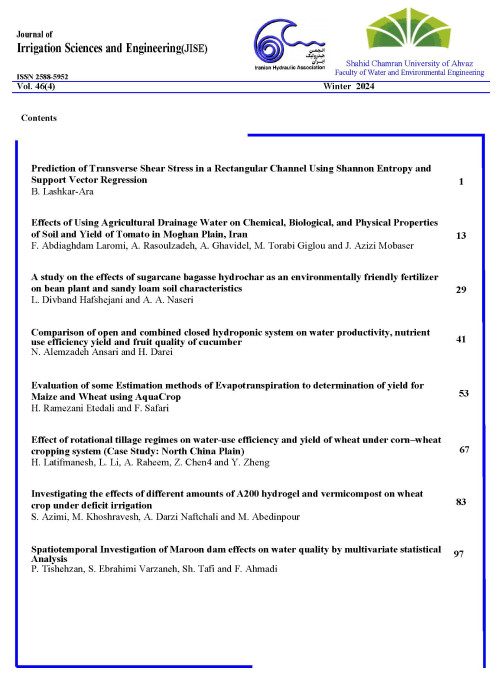Optimal Allocation of Water and Land under Conditions of Uncertainty Using WFGP Model (Case Study: the City of Hamadan)
Author(s):
Article Type:
Research/Original Article (دارای رتبه معتبر)
Abstract:
using mathematical programming models for determining appropriate cropping patterns has recently attracted a lot of attention. The agricultural sector is one of the most important and powerful economic sectors of the country. In the last ten years, its contribution to gross domestic product has been around 18% on average. The method of linear programming has been widely used in the fields of land allocation and determination of optimal cultivars since the 1960s. The purpose of linear programming is to maximize or minimize the objective function by considering a number of constraints and decision variables simultaneously. Fuzzy scheduling allows decision-makers to interfere with non-explicit data and data parameters in models. Compared to other models of math planning, it is more applicable and more flexible to be used in optimization problems and in determining the optimum crop cultivation patterns. Moreover, the results are more reliable (Rastegaripour and Sabouhi, 2009). Mir Karimi et al. (2016) investigated the optimal cultivar pattern in the city of Amol using the ideal planning and taking into account the goals of reducing fertilizer use by seven percent. Their results showed a one-percent reduction in pesticides to protect the environment and a reduction of 93% of water use for the conservation of scarce water resources and sustainable agricultural development. In this study, a fuzzy utopian planning model with three equal weight patterns, different weights, a decreasing weight and an incremental weight for ideals and water resource constraints are designed, taking into account environmental and economic objectives. The main objective of this research is to optimize water and land resources in Hamadan province. First, we introduced a weighted fuzzy goal programming model (WFGP). Using this model, optimum cultivating model for farmers in Hamadan was determined, considering their income goals, environmental goals and sustainability of water resources of the region. Subsequently, the allocation between irrigation water inputs and land surface was calculated considering equal weights, different weights and different decreasing weights for the desired goals.
Language:
Persian
Published:
Irrigation Sciences and Engineering, Volume:42 Issue: 2, 2019
Pages:
167 to 180
magiran.com/p2000137
دانلود و مطالعه متن این مقاله با یکی از روشهای زیر امکان پذیر است:
اشتراک شخصی
با عضویت و پرداخت آنلاین حق اشتراک یکساله به مبلغ 1,390,000ريال میتوانید 70 عنوان مطلب دانلود کنید!
اشتراک سازمانی
به کتابخانه دانشگاه یا محل کار خود پیشنهاد کنید تا اشتراک سازمانی این پایگاه را برای دسترسی نامحدود همه کاربران به متن مطالب تهیه نمایند!
توجه!
- حق عضویت دریافتی صرف حمایت از نشریات عضو و نگهداری، تکمیل و توسعه مگیران میشود.
- پرداخت حق اشتراک و دانلود مقالات اجازه بازنشر آن در سایر رسانههای چاپی و دیجیتال را به کاربر نمیدهد.
In order to view content subscription is required
Personal subscription
Subscribe magiran.com for 70 € euros via PayPal and download 70 articles during a year.
Organization subscription
Please contact us to subscribe your university or library for unlimited access!


